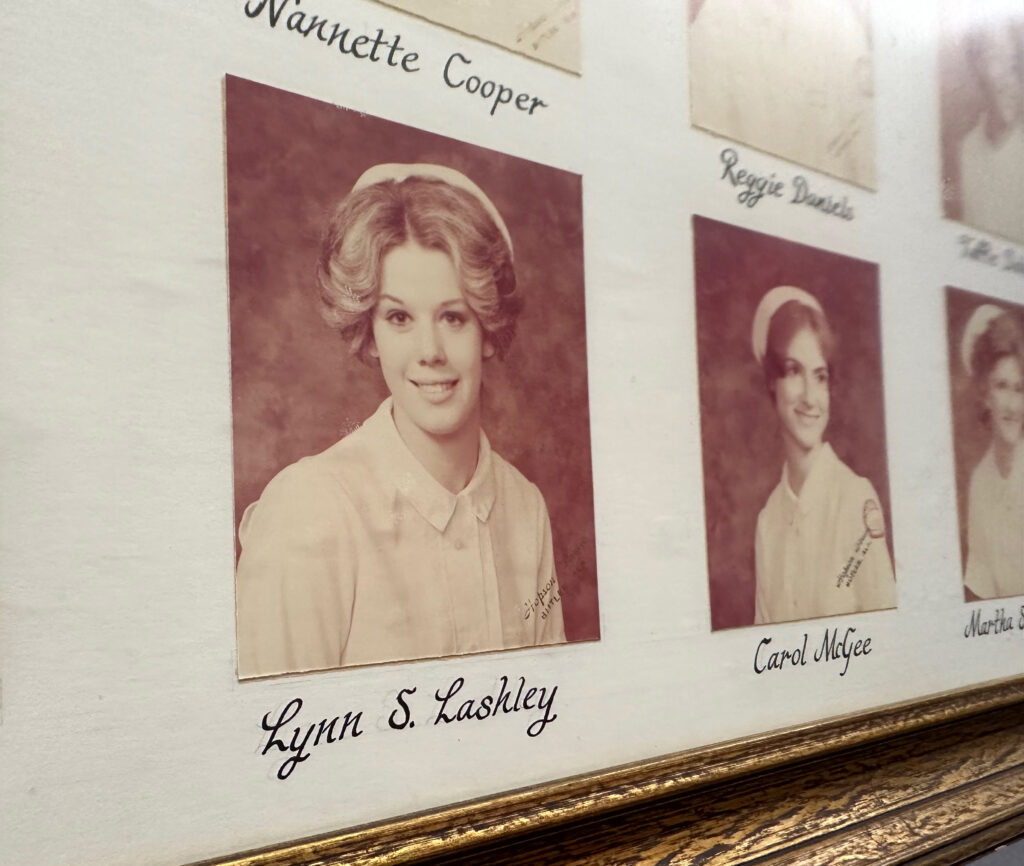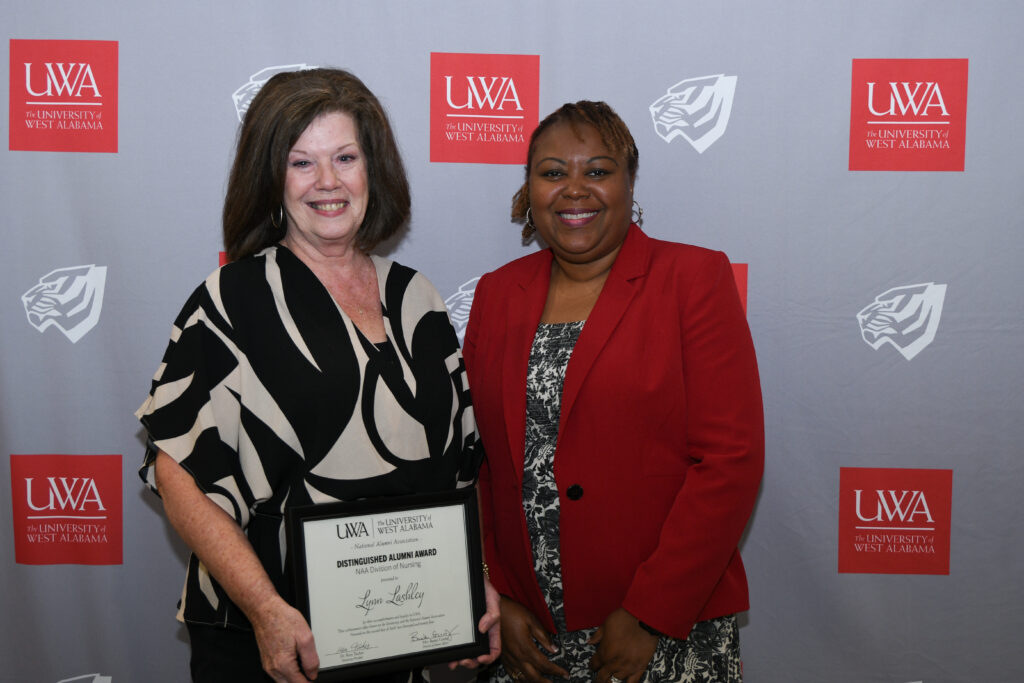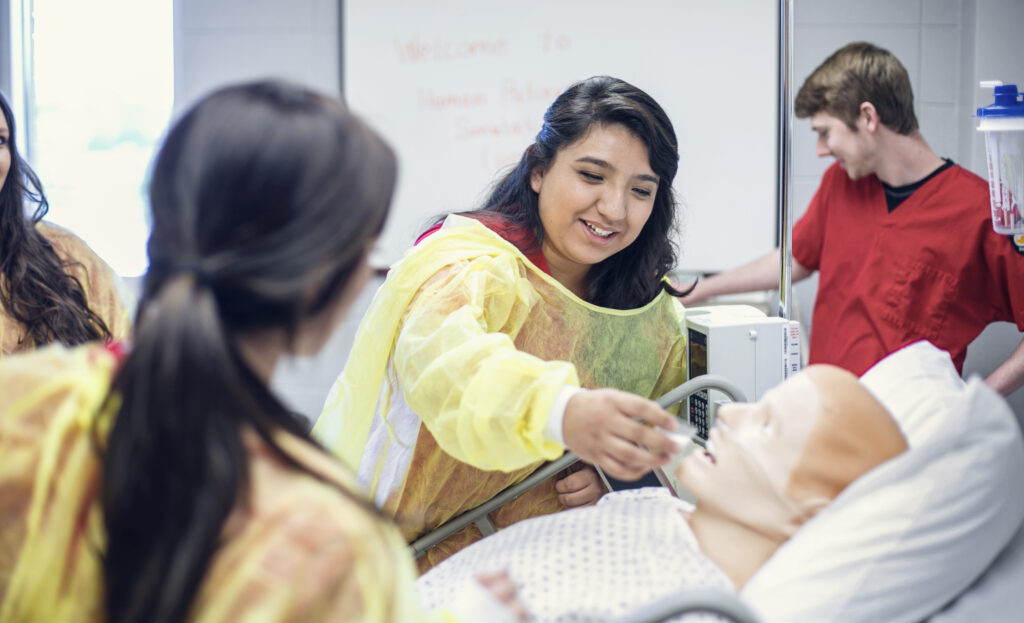
Story: Lisa Sollie | Photo: Cody Ingram
Few individuals know as much about nursing education at the University of West Alabama over the past five decades as Lynn Lashley does. Her journey reflects the program’s full evolution, from being a member of the inaugural class of then-Livingston University’s Associate Degree in Nursing program to her current role as a part-time retention specialist in the Ira D. Pruitt Division of Nursing.
Originally inspired to teach, Lashley, a Livingston native, opted for a career in nursing. After completing the nursing program in 1976, Lashley spent seven years in medical/surgical nursing. In 1983, Sylvia Homan, the program’s first nursing instructor, invited Lashley to join UWA as a part-time faculty member, marking a pivotal moment in her career.
Homan, Lashley recalled, had recently returned to the area, and the university wanted her on the faculty.
“Sylvia could only commit to working part-time at the university, so she proposed we share responsibilities. She would tackle the classroom curriculum if I taught clinical. Although I was still working full-time as a nurse, I knew I could do both jobs.”
When Homan became the Ira D. Pruitt Division of Nursing chair in 1985, Lashley gave up patient care, joining UWA as a full-time faculty member.

“It’s quite ironic,” laughed Lashley, “because I remember telling my mom, probably in my third quarter of nursing school, that maybe I’d chosen the wrong career field. Don’t get me wrong, I loved nursing, particularly clinical, but I wasn’t very excited about my nursing classes. As an instructor, this was my chance to create a fun, engaging learning environment for students.”
Fundamental changes in nursing education over the past 50 years run the gamut from clinical settings, equipment, and computerized testing to program development, retention, and mentorship. Thanks to dedicated leadership, including faculty and staff, UWA’s Ira D. Pruitt Division of Nursing has kept pace with the rapidly changing healthcare field.
Computerized testing
For the first 20 to 25 years of the program, tests were graded by hand, often 50-60 tests a week, Lashley noted. Faculty also evaluated test questions and decided whether they needed tweaking or, at times, thrown out. When the nursing division got a Scantron machine, a scanner that uses Optical Mark Recognition (OMR) to grade multiple-choice, fill-in-the-bubble tests, the burden of grading tests by hand was gone, and faculty now had statistical data to help back up their decisions on the effectiveness of the exam questions. The advent of the Scantron machine soon gave way to computerized testing, a practice still relevant today, where nursing students report to state-of-the-art computer labs to take their exams.
Computerized exams weren’t relegated only to the university during this time. “State boards, a paper licensure exam given only twice a year in Montgomery that nursing students had to pass to become a registered nurse,” recalled Lashley, “became known as the National Council Licensure Examination (NCLEX). Nursing graduates no longer have to travel but can schedule a day to take the NCLEX that works for them.”
Simulation
Lashley believes one of the most fundamental changes in nursing education over the years is skills training. When she was a student, this training primarily took place in the clinical setting, with visits to the simulation room occurring perhaps once a quarter.
“I’ll never forget the first time I went to give an intramuscular injection at the hospital here in Livingston. The chair of the Division, Dr. Brodt, went with me. As you can imagine, I was very nervous, and I was trying to give myself a pep talk as we walked down the hall with the syringe in my hand. When we got into the room to explain to the patient what I was there to do, Dr. Brodt went to lower the side rail and pulled it completely off the bed. She looked at me as if to say, ‘What do I do with this thing?’ I immediately felt myself relax, and I successfully administered the injection.”
Simulation is now an integral part of UWA’s nursing education system. Utilizing low-fidelity and high-fidelity simulation with life-like manikins to create realistic clinical scenarios, nursing students have daily access to eight simulation rooms to practice their skills assessments, be better prepared, and be more comfortable transitioning to the hospital setting.

Mentorship
“When I began teaching, Sylvia Homan was my role model and mentor. She taught me so much, and her guidance and knowledge were invaluable,” recalled Lashley, “I wanted the opportunity to mentor someone.” Years later, when the Division of Nursing implemented a more structured faculty mentor program pairing seasoned faculty with new incoming faculty, Lashley was paired with Mary Hanks.
In 2014, after a 29-year teaching career, Lashley took on the division head role. After she retired from this leadership position three years later, Mary Hanks, the new chair of the Ira D. Pruitt Division of Nursing, asked Lashley to return to the university part-time as a retention specialist. In this capacity, she works alongside students’ faculty mentors, assigned to incoming nursing students as a supportive figure who understands their challenges and can identify areas of improvement, to help prevent students from failing.
However, mere head knowledge, Lashley said, does not guarantee a student will develop into a caring nursing professional — a truth made clear years ago when one of her former nursing students had to perform her first venipuncture.
“The student was scared and nervous to start an IV, much like I was when I gave my first injection years earlier,” she reflected, “but I was able to talk them through the procedure, ensuring both the patient and my student had a good experience.”
Following the encounter in the hospital, Lashley was surprised to receive a sweet card from the family that read, ‘I just want you to know how impressed we were with your student and their skill set, but also how patient and supportive you were while talking them through the procedure.’ At the bottom of the card,” she continued, “was the quote, ‘People don’t care about how much you know until they know how much you care.'”
And at the end of the day, she noted, that’s the essence of nursing.